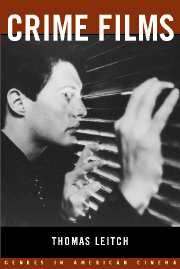Book contents
- Frontmatter
- Contents
- List of Illustrations
- Acknowledgments
- 1 The Problem of the Crime Film
- 2 Historical and Cultural Overview
- 3 Critical Overview
- 4 Fury and the Victim Film
- 5 The Godfather and the Gangster Film
- 6 Double Indemnity and the Film Noir
- 7 Basic Instinct and the Erotic Thriller
- 8 Murder on the Orient Express, Blue Velvet, and the Unofficial-Detective Film
- 9 Chinatown and the Private-Eye Film
- 10 Bullitt and the Police Film
- 11 Reversal of Fortune and the Lawyer Film
- 12 Fargo and the Crime Comedy
- 13 Conclusion: What Good Are Crime Films?
- Notes
- Selected Bibliography
- Filmography/Videography
- Index
9 - Chinatown and the Private-Eye Film
Published online by Cambridge University Press: 27 October 2009
- Frontmatter
- Contents
- List of Illustrations
- Acknowledgments
- 1 The Problem of the Crime Film
- 2 Historical and Cultural Overview
- 3 Critical Overview
- 4 Fury and the Victim Film
- 5 The Godfather and the Gangster Film
- 6 Double Indemnity and the Film Noir
- 7 Basic Instinct and the Erotic Thriller
- 8 Murder on the Orient Express, Blue Velvet, and the Unofficial-Detective Film
- 9 Chinatown and the Private-Eye Film
- 10 Bullitt and the Police Film
- 11 Reversal of Fortune and the Lawyer Film
- 12 Fargo and the Crime Comedy
- 13 Conclusion: What Good Are Crime Films?
- Notes
- Selected Bibliography
- Filmography/Videography
- Index
Summary
In his landmark 1944 essay “The Simple Art of Murder,” Raymond Chandler made no secret of his impatience with Golden Age detective stories. He dismissed as hopelessly farfetched, despite its similarity to the screenplay he coauthored for that year's Double Indemnity, a tale by Freeman Wills Crofts in which “a murderer by the aid of makeup, split second timing, and some very sweet evasive action, impersonates the man he has just killed and thereby gets him alive and distant from the place of the crime.” And the solution to Agatha Christie's Murder on the Orient Express, he concluded, was “the type guaranteed to knock the keenest mind for a loop. Only a halfwit could guess it.”
Certainly the hard-boiled story Chandler advocated and practiced, with its rough-and-tumble maze of tough “janes,” tougher private eyes, wholesale violence, and official corruption, seems poles apart from the orderly world of Hercule Poirot Chandler satirized in his semiparodistic story “Pearls Are a Nuisance” (1939) and throughout the series of novels beginning with The Big Sleep (1939) that upend their conventions of the suspects' class-bound isolation from the outside world and the detective's interrogations as a civilized game. The hard-boiled formula, like its near-contemporaries jazz and musical theater, is a peculiarly American invention, and one linked especially closely to the California landscapes of its two best-known practitioners, Chandler and his progenitor, Dashiell Hammett.
- Type
- Chapter
- Information
- Crime Films , pp. 192 - 214Publisher: Cambridge University PressPrint publication year: 2002



